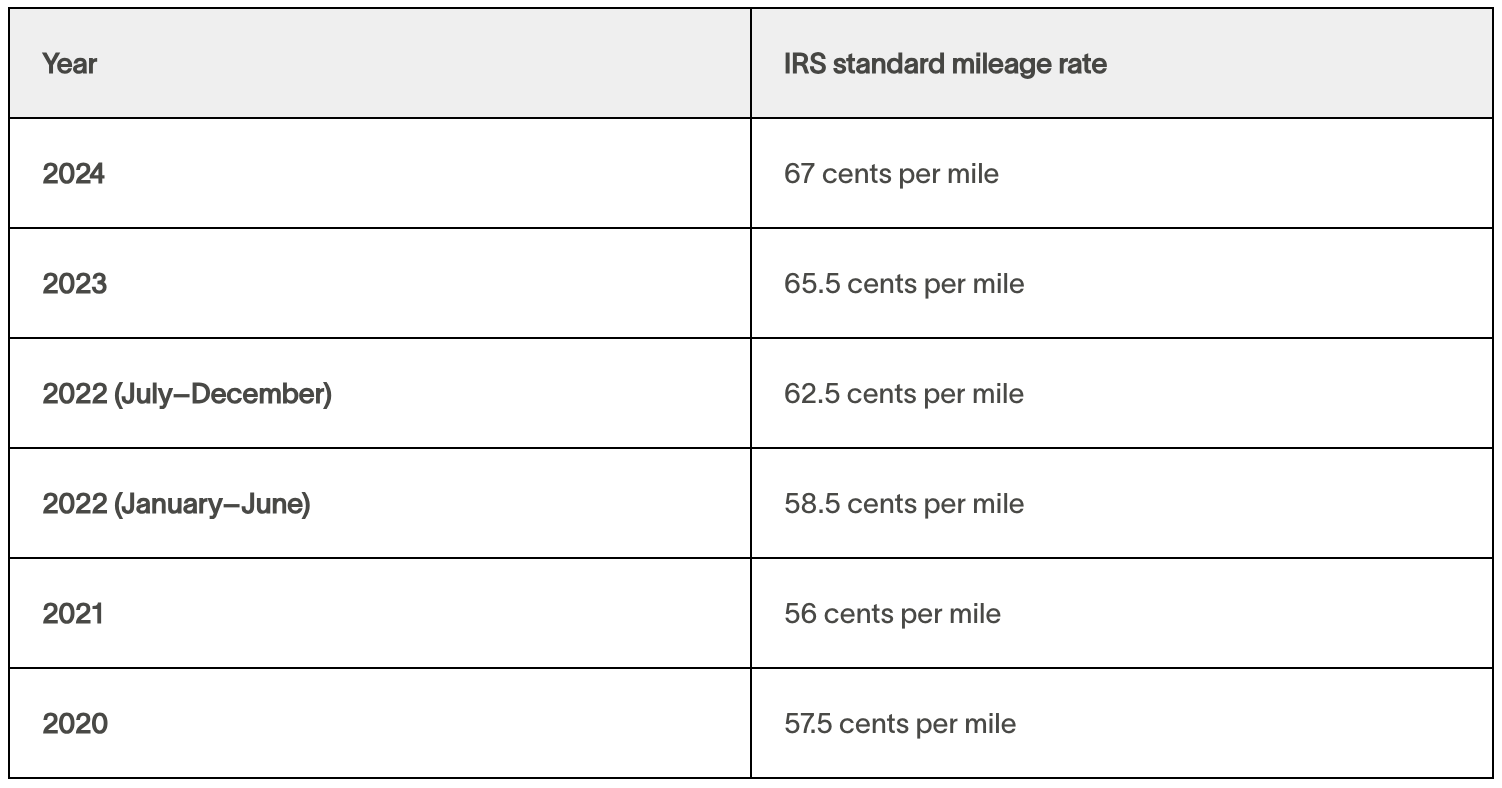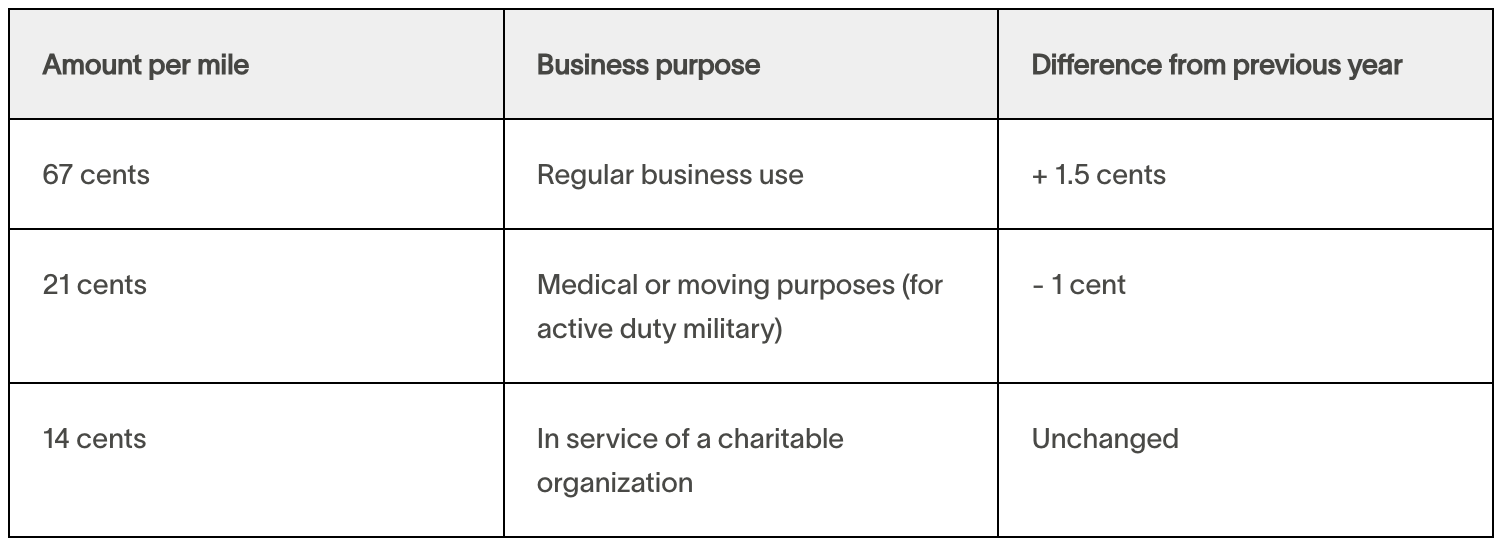Mileage reimbursement for businesses: What you need to know

Papilouz Studio // Shutterstock
Mileage reimbursement for businesses: What you need to know
A modern car’s analog speedometer.
Mileage reimbursement is the process of compensating employees who use their personal vehicle for business purposes. It helps cover car-related expenses like gas, maintenance, wear and tear, and more.
If your employees use their personal vehicles for business or to carry out work-related duties, it’s important to have a way to compensate them. To do that, it’s critical that you have a clear mileage reimbursement policy in place as part of your broader expense reimbursement policy.
Below, Ramp takes a closer look at mileage reimbursement and why it’s important, including when reimbursement makes sense and when it doesn’t, a review of the standard mileage rate, and answers to other common questions about employee mileage reimbursement.
What Is Mileage Reimbursement?
Mileage reimbursement is the amount a company repays employees who use their personal vehicles for business purposes. For jobs that require a lot of driving, mileage reimbursement is an alternative to providing an employee with a company vehicle or stipend.
Companies can choose to reimburse employees based on a flat, per-mile rate or reimburse the actual costs employees incur on each trip. Because mileage reimbursements are typically tax-deductible, the Internal Revenue Service, or IRS, provides specific guidelines around how companies should log mileage.
The IRS also publishes a standard mileage rate each year as a benchmark. Many employers choose to reimburse employees at the IRS standard mileage rate, but companies can choose whatever rate they deem appropriate.
What Counts as Reimbursable Mileage?
Any time an employee uses their personal vehicle for business purposes, you should consider reimbursing them for mileage. Common examples of business travel that may trigger mileage reimbursement include:
- Attending an off-site business meeting
- Driving to the airport or train station to then go on a business trip
- Picking up a business partner or coworker from the airport to attend a business meeting
- Visiting customers, clients, or prospects for sales meetings
- Transporting materials, equipment, or supplies to or from the office, worksite, or other location
Not all business mileage is reimbursable. Notably, mileage related to regular commuting is not reimbursable—it’s also non-deductible.
What Does Mileage Reimbursement Cover?
Mileage reimbursement does more than simply pay back the cost of gasoline. Other employee expenses that are typically reflected in mileage reimbursement rates include:
- Alternative fuels (ethanol, electricity, etc.)
- Maintenance
- Washing and cleaning
- Wear and tear
- Depreciation
- Car insurance
- Registration fees
- Licensing fees
It’s important to note that mileage reimbursement doesn’t cover all costs associated with driving. If your employee pays a toll while driving, for example, that won’t be reflected in their mileage reimbursement. Instead, it would need to be reimbursed separately as a travel expense.
Other vehicle expenses and driving costs that aren’t covered by mileage reimbursement include parking fees, concierge services, and others.
Understanding the IRS Standard Mileage Rate
Every year, the IRS sets the standard mileage rate for the business use of a car, van, pickup, or panel truck. This is the dollar amount that a business owner or self-employed individual can deduct from their income tax return for each business mile driven, effectively lowering their taxable income for the year.
The mileage rate varies based on the purpose of the travel, with unique rates for standard business use, medical or moving purposes for active-duty military, and miles driven in service of a charitable organization. Most businesses use the standard mileage rate as a benchmark for setting their own mileage reimbursement policies.
The standard mileage reimbursement rate fluctuates from year to year based on factors like inflation, the average cost of fuel, and other variables. Midyear adjustments occasionally occur, as in 2022. The table below shows the standard mileage rate for regular business purposes in each of the past three years:
![]()

Ramp
Standard Mileage Rate for Regular Business Use Over the Past 3 Years
Table showing mileage reimbursement rates from 2020-2024.
Your business doesn’t necessarily have to follow the IRS mileage rates. You’re free to set your company’s reimbursement rate however you see fit—whether that’s more or less than the standard rate. You can also choose to forego mileage reimbursements altogether and instead reimburse the actual expenses that your employees incur during business travel.
That being said, if you reimburse at a higher rate, the difference is considered taxable income for your employee. If you pay under the standard rate, you risk dropping your employee’s pay below the federal minimum wage, which violates the Fair Labor Standards Act, or FLSA.
Whatever your company’s mileage reimbursement rate, you should include it in your travel and expense policy.

Ramp
What Is the Current Mileage Reimbursement Rate for 2024?
Table showing current mileage reimbursement rates.
The 2024 mileage reimbursement rates are:
Looking ahead, the IRS is likely to announce the standard rate for the 2025 tax year in December. In the meantime, you can use a mileage reimbursement calculator to estimate your travel costs and plan ahead.
Is Mileage Reimbursement Legally Required?
Mileage reimbursement is sometimes required by law. Below is an overview of some of the laws that may require you to reimburse your employees for company mileage.
Federal Laws
As of 2024, there is no federal mileage reimbursement requirement. Under the FLSA, however, employers are legally required to reimburse employees for business expenses if failure to do so would drop their earnings below the federal minimum wage. This includes reimbursement for the costs of using a personal vehicle for business purposes.
For companies where the average employee earns well above the minimum wage, this likely isn’t much of a concern. But for companies where the average worker earns at or near the federal minimum wage, you should be certain that your mileage reimbursement policy (or lack thereof) complies with FLSA requirements.
State Laws
Despite the lack of a formal federal law, some states—specifically California, Illinois, and Massachusetts—currently have laws on the books that require mileage reimbursement. While these laws don’t specify a required rate of reimbursement, most tend to follow the IRS standard mileage rate as a benchmark. Make sure your mileage reimbursement rules reflect these regulations if you have employees in these locations.
Benefits of Employee Mileage Reimbursement
Even when it’s not required, reimbursing mileage can benefit your business.
First, consider that employees will be more willing to drive their personal vehicle on the job when they know that they’ll be reimbursed for the costs. This empowers your employees and your business to act nimbly and jump on opportunities as they pop up—putting in the extra effort to visit a client in person, for example, or touring the facility that manufactures your product.
Mileage reimbursement can even help with employee attraction and retention, especially for positions where driving is a big part of the job. In this way, reimbursements can serve as a more cost-effective alternative to providing an employee with a company car or car allowance.
Finally, as noted above, mileage reimbursement comes with some tax benefits. Specifically, it can provide your business with a tax deduction because mileage reimbursements count as a deductible business expense.
Tracking and Managing Mileage Reimbursement
There are several mileage-tracking apps that make it easy to record miles driven for personal vs. business purposes. If you prefer to keep things low-tech, you might require your employees to keep a manual mileage log for any business travel.
This logbook should include the trip’s date, business purpose, and the total miles driven. Odometer readings before and after the drive offer the most accurate estimate for miles driven, especially compared to map estimates or other methods.
When it comes to creating and managing your mileage reimbursement policy, you’ll want to consider a few factors:
- Determine your rate: You can use the standard mileage rate as a baseline, but you’ll want to account for local and regional differences like gas prices and overall cost of living
- Outline the reimbursement process: As part of your overall expense reimbursement policy, set guidelines for how employees should report mileage, the documentation they must submit as proof, and when and how they’ll be reimbursed. The easiest way to manage this process is with expense management software.
- Keep accurate records: If you plan to write off mileage reimbursements on your tax returns, you need to keep organized and accurate records of the submitted expenses and the reimbursements you paid. The IRS has specific guidelines around recordkeeping requirements for car expenses.
This story was produced by Ramp and reviewed and distributed by Stacker.